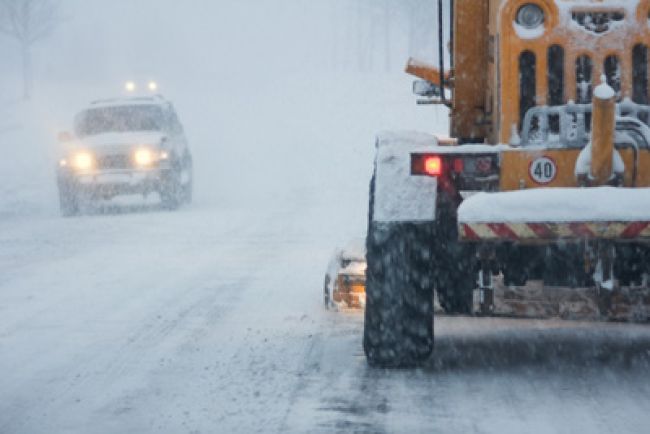
Best Practices for Winterizing Your Fleet
A 70-inch snowfall in Buffalo, N.Y. A polar vortex. An ice storm in the South. The last few winters certainly have been memorable, and this coming season looks to be more of the same. The National Weather Service’s Climate Prediction Center (www.cpc.ncep.noaa.gov) is forecasting below-normal temperatures for much of the U.S., with some locations experiencing more precipitation than average.
While this may be good news for skiers and those who like to build snowmen, it can wreak havoc for utility fleets – those pressed to keep services operating no matter the weather.
“When you’re in our business, the power has to be on 24/7,” said Michael Donahue, manager of transportation and construction equipment for Omaha Public Power District (www.oppd.com). “The crews and vehicles and equipment have to be ready to respond for normal maintenance and when there is an emergency.”
Given that the average high temperature in Omaha, Neb., hovers around the freezing mark during the winter months, winterizing the utility’s fleet is a given. Historically, the OPPD fleet maintained its 1,000 licensed vehicles and 300 pieces of construction equipment by issuing preventive maintenance orders each September 1. “But what that did was put 1,000 PMs due on our list,” Donahue explained. Now the fleet garage incorporates winterization into the normal maintenance schedule. “It eases up on the guys in the shop and the crews, too,” he said.
In Nova Scotia, another region that is typically frozen during the winter, preparation is key – and it starts at the most basic levels.
“As we approach the winter season, an email is sent out to the line supervisors to check and make sure all outlets are working where trucks are to have their block heaters plugged into,” said Allan Bates, fleet garage supervisor at Nova Scotia Power (www.nspower.ca). Supervisors also are reminded to ensure adequate supplies of fuel conditioner and winter washer fluid are available, he said.
Keeping the fleet ready for response means block heaters are installed on all trucks and winter tires are changed out before they are worn down to 5/32 of an inch, Bates said. Block heaters keep the engine warm and lubricants flowing, and they are especially important for diesel trucks. Research performed by the University of Tennessee found that diesel engines are five times harder to start in zero-degree weather than in 80-degree temperatures.
Here are some other winterization tips from Bates, Donahue and equipment supplier McCann Industries (www.mccannonline.com).
Watch out for water, which can freeze in any number of a vehicle’s systems. This means checking washer fluid to ensure it is winter-rated – likely with a higher concentration of alcohol to prevent freezing. It also means changing fuel filters. Bates said Nova Scotia Power schedules that maintenance to occur every two months. A clogged fuel filter can cause moisture buildup. Condensation also can build up inside nearly empty fuel tanks, creating difficulties in starting.
Add fuel conditioner and ensure that it is appropriate for the type of fuel used. This is especially important for ultralow sulfur diesel. Fuel additive manufacturer Enertech Labs (www.enertechlabs.com) reports that this type of fuel gels at higher temperatures than other types of diesel and is prone to icing.
Check coolant and antifreeze and adjust frequently. Additionally, switch out wiper blades in favor of those designed for winter conditions.
Check tire inflation often. Tire manufacturer Goodyear (www.goodyear.com) notes that tire pressure drops 1-2 pounds for every 10-degree decline in temperature. Properly inflated tires also can help with slippery conditions. It is interesting to note that at OPPD, crews no longer carry tire chains. “They didn’t use them very often and when they would take them out, they would be rusty,” Donahue said. Now, storage is built into the utility’s parking facilities and crews can grab chains if they know they will need them.
Plug in block heaters during periods of normal operating temperatures. Block heaters do not provide heating – they maintain temperature.
About the Author: Sandy Smith is a freelance writer and editor based in Nashville, Tenn.
*****
3 Things You May Not Know About Winter Weather
1. While frostbite and hypothermia may be well-known wintertime threats, workers also can encounter other, less severe cold-weather injuries, according to the U.S. Army Public Health Center. Chilblain occurs when skin is exposed to cold or wet conditions. It can be as warm as 50 degrees Fahrenheit and happen in an hour or so. Immersion or trench foot occurs when tissue – especially in the feet – is exposed to cold, wet temperatures for 12 hours or more. Inactivity, wet or damp socks, or tightly laced boots that impair circulation all can speed up onset and severity.
2. More Americans die of causes related to winter weather exposure than to summer heat. The National Center for Health Statistics, a division of the Centers for Disease Control and Prevention, says about 2,000 Americans die of weather-related causes each year, and about two-thirds of those are due to exposure to cold. In Canada, about 108 people die annually from the cold, compared to 17 who succumb to heat-related ailments.
3. Canada ties Russia as the coldest nation on earth, with an average daily annual temperature of -5.6 degrees Celsius, according to “Canadian Geographic Biggest and Best of Canada: 1000 Facts & Figures.” That equates to about 22 degrees Fahrenheit.

